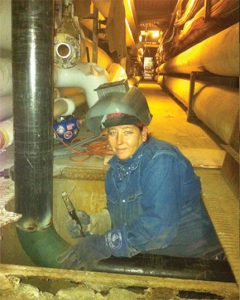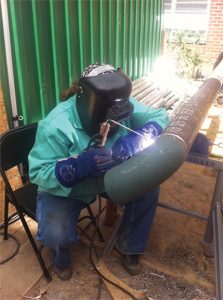Executive of the Month: Janet Powers, business agent for Steamfitters Local 638: Proud to rep union where women are treated and paid equally
Suffolk County, NY The New York Real Estate Journal recently sat down with Janet Powers, Steamfitters Local 638 business agent for members in Eastern Suffolk County, for a question and answer session.
Q: You recently became the first female business agent in Steamfitters Local 638’s 132-year history. Why did you decide to run for this position?
A: Union business agents play an integral role in upholding our industry’s trade agreements, ensuring workplace safety and advocating for workers’ rights. We protect and represent employees’ interests and promote a safe, healthy work environment. As business agent for union steamfitters in Eastern Long Island, I act as a liaison with property owners and developers regarding issues of concern, which may include safety or labor disputes. As a 29-year steamfitter whose welfare on the job has been continually represented and defended by business agents, I recognize how critical this role is. Ensuring others have workplace rights and protections is something I’m incredibly passionate about.
Q: What’s it like to be a female leader in an industry that, nationwide, is vast majority male workers?
A: I’m proud to represent a union where women are treated and paid equally. Over the last three decades, I have seen more women on union jobs and I have personally mentored male and female steamfitters alike. It’s rewarding to pass down knowledge and experience, just as I was taught the trade by those who came before and mentored me. I was honored to be the first woman nominated and elected to Local 638’s finance committee and later won a position on the union executive board. My colleagues also elected me as delegate to the 36th, 37th and 38thUnited Association National Conventions.
Q: What exactly does a steamfitter’s work consist of?
A: Steamfitters design, install and maintain key building operating systems. This includes: fire sprinklers; refrigeration; heating and cooling systems; steam and water piping in many tens of thousands of high-occupancy commercial, residential, industrial buildings and power plants throughout the New York region. These systems are effectively the hearts, lungs and arteries of buildings. The employment of steamfitters, pipefitters and plumbers is projected to grow 12% from 2012 to 2024, faster than any other occupation, according to the Bureau of Labor Statistics.
Q: Governor Cuomo’s Reforming the Energy (REV) plan aims to improve New York’s infrastructure and reduce greenhouse gas emissions 80% by 2050. How can building owners contribute to these goals?
A: Many of New York’s aging buildings contain piping, heating and ventilation systems that have reached or surpassed their life expectancy. With age, the insides of pipes calcify and clog, leading to blockages, leaks, ruptures and elevated utility costs. This was the case for the historic 1960’s era Penn South housing development complex. About five years ago, management recognized that more apartments were experiencing leaks and flooding. Steamfitters were brought in to modernize the piping and mechanical infrastructure, resulting in an immediate annual 15% energy use reduction and an estimated $86 million utility cost savings. It was an investment in that building complex’s future that paid the landlord’s investment back within a matter of a few short years.
Q: Can you share some of the major projects you’ve worked on throughout your career?
A: I’ve worked on Bloomberg Tower, Rockefeller University, Central Islip Courthouse and the renovation of the Penn South complex. I specialize in industrial work, having helped build the Stony Brook University Power House; John F. Kennedy International Airport Power Plant; Con-Ed Powerhouse 14th St., where I served as deputy foreman; Ravenswood No. 3; Charles Poletti Power Project in Astoria; and the Astoria Powerhouse adjacent to the East River.
Q: You’ve worked on a lot of power plants. After witnessing their impact on surrounding communities, what are your thoughts about the proposed Caithness Long Island II power plant?
A: It’s absolutely necessary. The Long Island Power Authority says the 752-megawatt (MW) power plant is needed to meet capacity shortfalls of up to 1,200 MW by 2022. Long Islanders need clean energy, lower rates (Caithness says the plant will save taxpayers a whopping $3.8 billion in fuel costs over 20 years), more jobs, a boost for the local economy and a cleaner environment. What happens when the next storm of the century comes? Hurricane Sandy was proof that we need resilient infrastructure in the face of extreme weather events. In-state power generation is what keeps New York self-sufficient, competitive and prosperous.
Q: Are there any Long Island power plants at which Steamfitters are performing work?
A: We are now modernizing the Stony Brook University West Central Power Plant, expected to be completed this year. The upgrade and expansion includes new boilers, electric chillers, hot water pumps, refurbished turbines and a high-temperature hot water system. The chill water system is also being replaced with a primary-secondary system to increase energy efficiency. I’m thrilled to oversee this work because years ago, I installed cooling towers at the power plant and performed x-ray repair welding, a specialty that few female steamfitters are skilled in. It’s exciting for me to return to this project, now playing a much larger role.
Q: Steamfitters are also responsible for installing fire sprinklers. Why is this work meaningful to you?
A: We are currently installing fire sprinklers at Stony Brook University’s new dining and residence halls, which will have 759 dorm rooms equipped with sprinklers. According to the National Fire Protection Association, fire sprinklers reduce fire fatalities by 82% and property damage by 68%. If that’s not convincing enough, Underwriters Laboratories and the National Institute of Standards and Technology find that modern fires burn 800% faster today than just a few decades ago due to increased use of petroleum-based synthetics in home and office furnishings and modern construction materials. A one-time investment in fire sprinklers can protect lives and property 24/7/365 for decades to come.
Q: What are some other local projects we can look forward to?
A: It’s an exciting time for Long Island’s real estate landscape! Stony Brook University is constructing a 240,000 s/f Medical and Research Translation building adjacent to Stony Brook Hospital, which will open this year as an incubator for cancer research and care. Also expected to open this year is Brookhaven Memorial Hospital’s Knapp Cardiac Care Center, which will enable the hospital to provide enhanced cardiac care and education. The infrastructure we are installing, such as state-of-the-art steam sterilizers and fire sprinklers, are so vital for the safety of medical facilities.
Suffolk County IDA supports expansion of A&Z Pharmaceuticals


The evolving relationship of environmental consultants and the lending community - by Chuck Merritt
When Environmental Site Assessments (ESA) were first part of commercial real estate risk management, it was the lenders driving this requirement. When a borrower wanted a loan on a property, banks would utilize a list of “Approved Consultants” to order the report on both refinances and purchases.












.jpg)